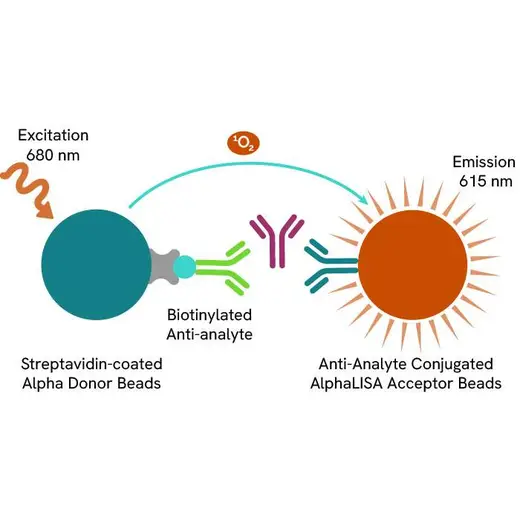
AlphaLISA Mouse IFNα Detection Kit, 100 Assay Points














The AlphaLISA® immunoassay kit for IFNα is designed for the quantitative determination of mouse interferon-alpha (IFN-α) in serum, buffered solution and cell culture supernatants using a homogeneous AlphaLISA assay (no wash steps).
For research use only. Not for use in diagnostic procedures. All products to be used in accordance with applicable laws and regulations including without limitation, consumption & disposal requirements under European REACH regulations (EC 1907/2006).
Product information
Overview
Formats:
- Our 100 assay point kit allows you to run 100 wells in 96-well format, using a 100 µL reaction volume (10 µL of sample).
- Our 500 assay point kit allows you to run 500 wells in 96-well or 384-well format, using a 50 µL reaction volume (5 µL of sample).
- Our 5,000 assay point kit allows you to run 5,000 wells in 96-well or 384-well format, using a 50 µL reaction volume (5 µL of sample).
Features:
- No-wash steps, no separation steps
- ELISA alternative technology
- Sensitive detection
- Broad sample compatibility
- Small sample volume
- Results in less than 3 hours
- Half the time of an ELISA assay
Inteferon-alpha (IFN-α) is a cytokine involved in innate immune response against viral infection. It is produced by leukocytes and other cell types like plasmacytoid dendritic cells. There are many IFN-α subtypes, with molecular weights ranging from 15 to 21 kDa. They all possess the same antiviral activity, but may differ in their relative biological activities. IFN-α also exhibits several antiproliferative and antitumor activities, making it one of the most used cytokine treatments in cancer patients suffering from hairy cell leukemia, renal carcinoma, Kaposi’s sarcoma, and other malignancies. Under physiological conditions, a low level of IFN-α is detected. However, its production is markedly enhanced during infections and various pathological situations, making IFN-α a major disease marker.
AlphaLISA technology allows the detection of molecules of interest in a no-wash, highly sensitive, quantitative assay. In an AlphaLISA assay, a biotinylated anti-analyte antibody binds to the Streptavidin-coated Donor beads while another anti-analyte antibody is conjugated to AlphaLISA Acceptor beads. In the presence of the analyte, the beads come into close proximity. The excitation of the Donor beads causes the release of singlet oxygen molecules that triggers a cascade of energy transfer in the Acceptor beads, resulting in a sharp peak of light emission at 615 nm.
Specifications
| Application |
Protein Analysis & Detection
|
|---|---|
| Assay Points |
100
|
| Assay Target Class |
Cytokine
|
| Brand |
AlphaLISA
|
| Detection Method |
Alpha
|
| Experimental Type |
In vitro
|
| Format |
Microplates
|
| Quantity in a Package Amount |
1.0 Units
|
| Shipping Conditions |
Shipped in Blue Ice
|
| Unit Size |
100 Assay Points
|
Image gallery












Video gallery



SDS, COAs, Manuals and more
Are you looking for technical documents for this product. We have housed them in a dedicated section., click on the links below to explore.


How can we help you?
We are here to answer your questions.































